Muscle Insider
New member
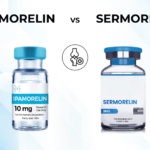
In the world of the anti-aging process, there are plenty of available to increase growth hormone levels. Two of the most prominent options include Ipamorelin and Sermorelin.
Ipamorelin mimics ghrelin, which can help increase growth hormone production, whereas Sermorelin is a synthetic version of a Growth Hormone Releasing Hormone which can alleviate a growth hormone deficiency.
Some pretty big words, right? Well, both of these chains of amino acids can lead to increased lean muscle mass, lower body fat, improved body composition, improved immune system, and even better cognitive function.
But which of these two is best? In the growth factor family of peptide therapy, which one should be on your shopping list?
Key Takeaways
[*]Ipamorelin is a ghrelin mimic which can lead to increased growth hormone production
[*]Sermorelin is a synthetic version of a Growth Hormone Releasing Hormone which can also increase growth hormone production
[*]Sermorelin studies are rare, but the few that are available do indicate that it can increase HGH and IGF-1 levels [1]
[*]Ipamorelin is effective, yet far more effective when used in conjunction with CJC-1295
[*]Both Sermorelin and Ipamorelin can be used in the treatment of those who suffer from a rapid decline in Growth Hormone output
[/list]
/wp-content/uploads/2023/08/Muscle-and-brawn-02-2.svg
Ipamorelin vs Sermorelin Comparison
IpamorelinSermorelinStructure






Understanding Growth Hormone
Growth hormone (GH), produced by the pituitary gland, is a vital peptide hormone that plays a central role in regulating growth, development, and metabolic processes within the human body.
Its primary function is to stimulate the growth and regeneration of cells and tissues, influencing bone and cartilage growth in particular. Beyond its pivotal role in height development during childhood and adolescence, GH continues to exert influence throughout adulthood, contributing to the maintenance of bone density, muscle mass, and overall organ health.
Moreover, growth hormone actively participates in metabolic activities, enhancing the utilization of fats for energy and sparing glucose.
This dual role underscores its significance in fostering optimal physical development and metabolic equilibrium. Imbalances in growth hormone secretion can lead to various developmental disorders or metabolic irregularities, emphasizing its critical role in maintaining physiological homeostasis.
Mechanism of action: How growth hormone stimulates growth
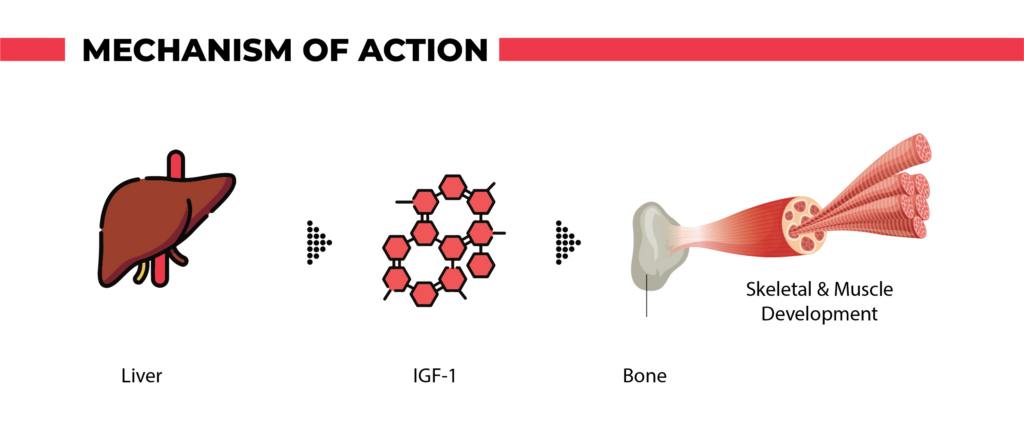
Growth Hormone (GH) plays a pivotal role in the stimulation of insulin-like growth factor (IGF-1) production within the liver and various other tissues. When GH binds to its receptors, it triggers the release of IGF-1, also known as somatomedin C. IGF-1 acts as a mediator of GH’s effects on growth and development, particularly in skeletal tissues and muscles.
IGF-1 promotes muscle growth by stimulating both the proliferation and differentiation of muscle cells, known as myoblasts. It enhances protein synthesis and inhibits protein breakdown, fostering a positive net balance of muscle protein. Furthermore, IGF-1 promotes the uptake of amino acids, the building blocks of proteins, by muscle cells.
The combined effects of HGH levels and IGF-1 contribute to the hypertrophy (increase in muscle size) and hyperplasia (increase in muscle cell number) of skeletal muscles, ultimately resulting in enhanced muscle mass. This intricate interplay underscores the significance of the GH-IGF-1 axis in regulating muscle growth and overall body composition.
The Role of Growth Hormone Releasing Hormone (GHRH)
Function of GHRH in signaling the pituitary gland
Growth Hormone-Releasing Hormone (GHRH) serves as a crucial regulator in the endocrine system, specifically in signaling the pituitary gland to release Growth Hormone (GH). GHRH is produced by the hypothalamus, a region in the brain, and acts on the somatotrophs, which are cells in the anterior pituitary gland.
The primary function of GHRH is to stimulate the synthesis and secretion of GH. GHRH binds to specific receptors on the surface of somatotrophs, triggering a cascade of intracellular signaling events. This signaling cascade ultimately leads to the release of stored GH into the bloodstream.
Linking GHRH to synthesis and secretion of human growth hormone
In a study titled “Normal Physiology of Growth Hormone in Adults” it is clearly stated that “Pituitary synthesis and secretion of GH is stimulated by episodic hypothalamic hormones. Growth hormone releasing hormone (GHRH) stimulates while somatostatin (SST) inhibits GH production and release. GH stimulates IGF-I production which in turn inhibits GH secretion at both hypothalamic and pituitary levels.” [2].
It goes further to explain that the gastric peptide ghrelin is also a potent GH secretagogue that can amplify GHRH secretion, leading to higher growth hormone levels, as seen in the figure below.
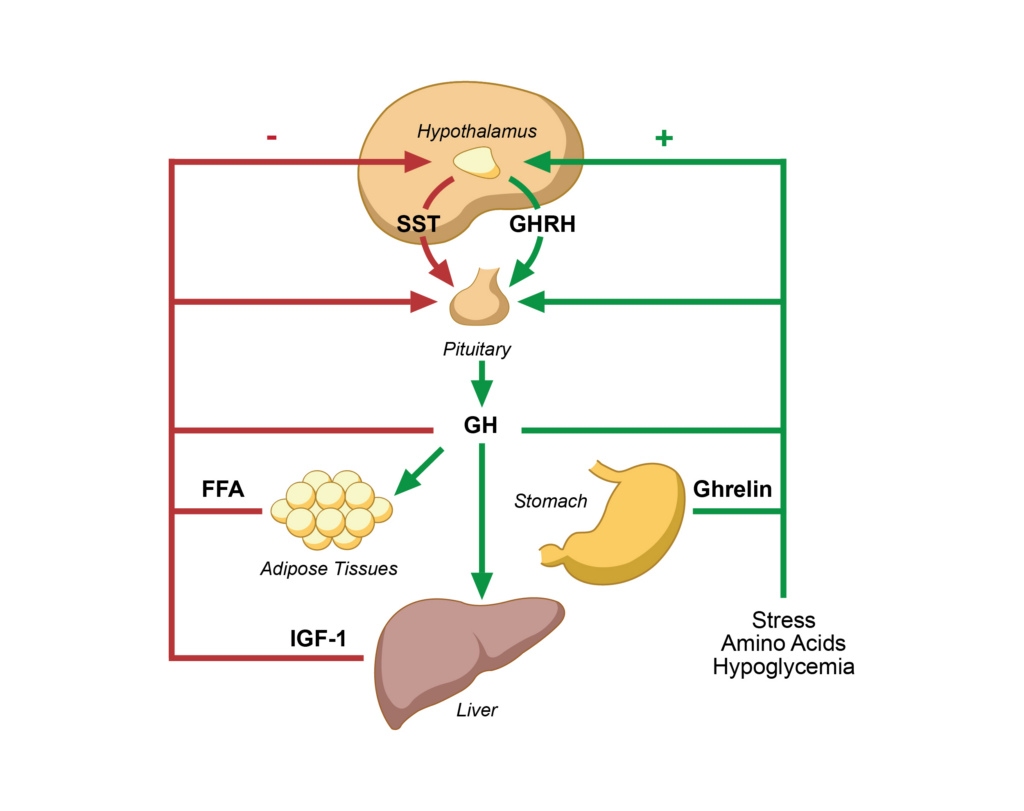
Ipamorelin: The Peptide Perspective
Ipamorelin SummaryIpamorelin
Ipamorelin is a pentapeptide (Aib-His-D-2-Nal-D-Phe-Lys-NH2), which displays high GH-releasing potency and efficacy in vitro and in vivo.Ipamorelin, a selective growth hormone-releasing peptide, has emerged as a promising agent for female fat loss.
Research shows that this compound can increase the body’s natural production of growth hormone by up to 30%. Growth hormone plays a pivotal role in fat metabolism, making its elevation crucial for effective fat loss.
For women, especially those over 40, natural growth hormone levels start to decline, leading to slower metabolism and increased fat storage. Ipamorelin’s ability to boost these levels can counteract this decline, potentially accelerating fat loss by up to 20%.
Moreover, unlike other growth hormone stimulants, Ipamorelin doesn’t increase appetite. This means women can benefit from its fat-burning properties without the counterproductive urge to eat more.
Additionally, a study found that participants using Ipamorelin experienced a 14% reduction in visceral fat over a 12-week period. Visceral fat, often termed “dangerous fat”, is linked to numerous health risks, making its reduction vital for overall health.
In summary, Ipamorelin offers a scientifically-backed approach to female fat loss, enhancing growth hormone levels, accelerating metabolism, and reducing harmful visceral fat, all without triggering increased appetite.








? Men/Women: Men and women
 Go to the Full review
Go to the Full review [/i]
- Muscle gain
- Fat Loss
- Increased bone density
- Injection site pain
- Insulin resistance
Ipamorelin is a synthetic pentapeptide identified as a potent growth hormone (GH) secretagogue, characterized by its high efficacy in stimulating GH release both in vitro and in vivo. Comprising the sequence Aib-His-D-2-Nal-D-Phe-Lys-NH2, it lacks the central dipeptide Ala-Trp found in growth hormone-releasing peptide (GHRP)-1.
In vitro studies demonstrated its GH-releasing potency comparable to GHRP-6. The pharmacological profiling indicated that, like GHRP-6, ipamorelin stimulates GH release through a GHRP-like receptor [3, 4].
Moreover, ipamorelin’s specificity for GH release, akin to growth hormone-releasing hormone (GHRH), makes it a promising candidate for clinical development. In addition to its role as a GH stimulator, ipamorelin mimics ghrelin, selectively binding to the ghrelin/GHS receptor pathway, influencing anabolic processes like appetite regulation, fat metabolism, and overall energy usage.
Studies on ipamorelin’s effects on postoperative ileus (POI) reveal potential benefits in improving gastric motility. Clinical trials suggest its potential in hastening the return of gastrointestinal function in patients undergoing bowel resection.
Furthermore, ipamorelin demonstrates significant effects on adiposity and weight gain, functioning independently of GH. It induces adipogenic effects, leading to early weight gain that stabilizes over time, without the organomegaly associated with GH treatment.
While limited studies explore its effects on hypogonadism, ipamorelin’s interactions with the GI tract underscore its impact on body composition. Human studies are needed to further evaluate ipamorelin’s role in treating hypogonadal and eugonadal patients, emphasizing its potential as a selective GH stimulator with diverse physiological influences [3, 4].
Sermorelin: Unveiling its Mechanism
Sermorelin SummarySermorelin
Sermorelin, an acetate salt, is a synthetic peptide containing 29 Amino acids. This artificial peptide (GRF 1-29 NH2) mimics the action of naturally occurring growth hormone-releasing hormone (GHRH) composed of 44 Amino acid residues.
The growth hormone-releasing hormone receptors (GHRHr) are located in the anterior pituitary gland. Sermorelin binds with these receptors to trigger the increased production and secretion of growth hormone (GH) by somatotroph cells.
As feedback mechanisms maintain the hormonal levels, the increased serum concentration of growth hormone (GH) stimulates another endogenous hormone called somatostatin, also known as growth hormone inhibiting hormone (GHIH).
Growth hormone inhibiting hormone (GHIH) initiates a negative feedback mechanism to stop the secretion of any more growth hormone (GH) by the somatotroph cells so that hormonal levels don’t overshoot.
Thus, sermorelin makes sure to keep the entire homeostatic coordination of the hypothalamus-pituitary-somatostatin intact.
Apart from this, sermorelin also improves the sleep-related circadian rhythm by reducing the production of stress hormones. This further amplifies the release of growth hormone (GH).
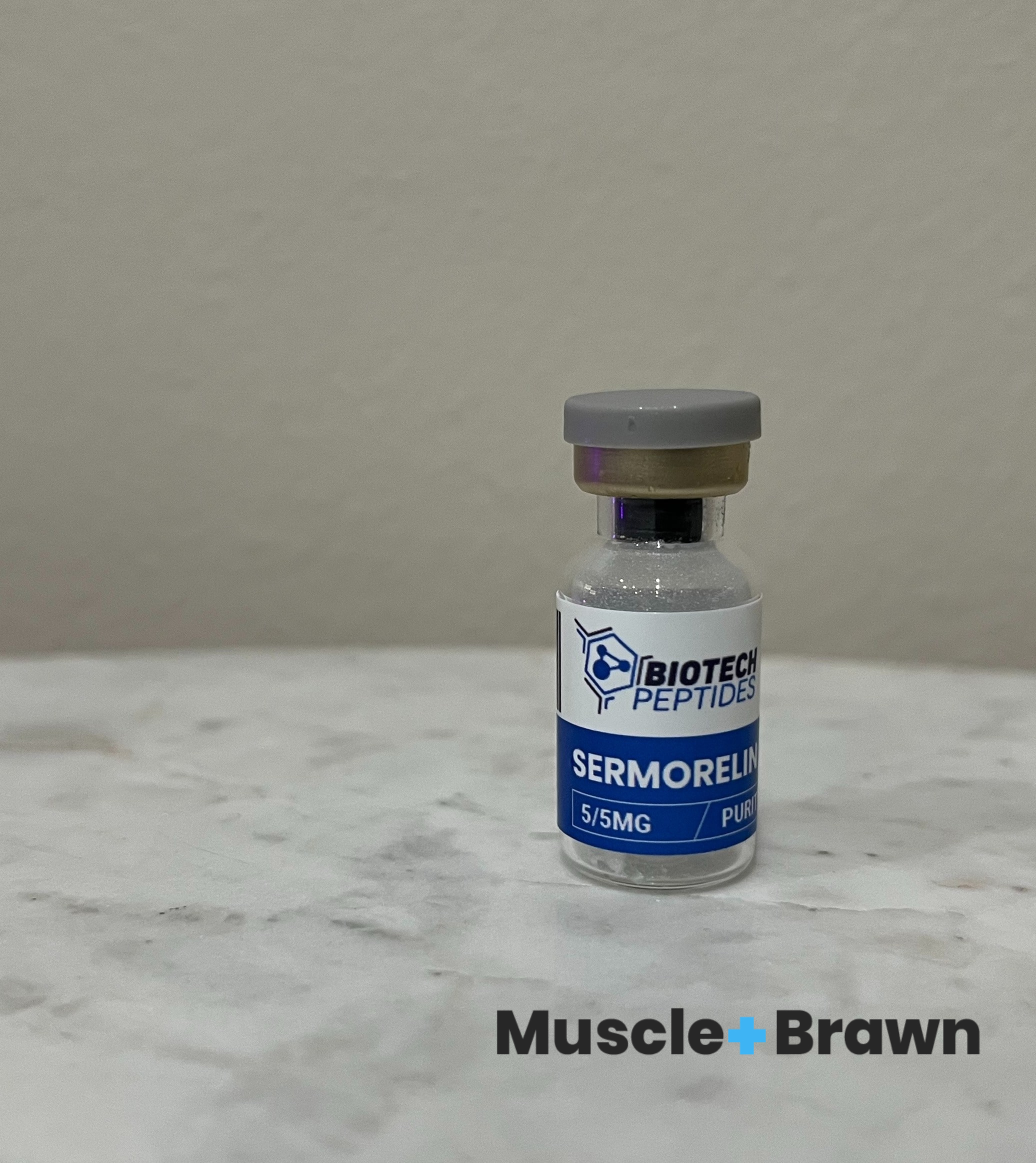







? Men/Women: Men and women
 Go to the Full review
Go to the Full review [/i]
- Enhanced muscle growth
- Efficient healing of wounds
- Reduces body fat
- Better sleep quality
- Improves brain functioning
- Cardiovascular growth
- Injection site pain
- Insulin resistance
- might experience headaches, nausea, dizziness, flushing, allergic reactions, loss of taste, hyperactivity, and paleness of skin
Sermorelin, a 29-amino acid analog of human growth hormone-releasing hormone (GHRH), offers a distinctive alternative for Growth Hormone Replacement Therapy (GHRT) in aging adults. Unlike recombinant human growth hormone (rhGH), which was unsuccessful as a growth-promoting agent in children, sermorelin’s efficacy in stimulating the pituitary gland makes it a viable option for aging individuals.
The molecule, initially marketed for pediatric use, was withdrawn as a therapeutic entity but gained renewed attention for its potential in GHRT for aging adults. Sermorelin operates by binding to specific receptors in the pituitary gland, stimulating the production and secretion of endogenous human growth hormone (hGH) [5, 6].
Studies suggest that sermorelin, in combination with arginine, may serve as a specific test for growth hormone deficiency, particularly in children. Subcutaneous administration of sermorelin has demonstrated efficacy in treating prepubertal children with idiopathic growth hormone deficiency, inducing catch-up growth and sustained height velocity over 12 months. However, the long-term effects on final adult height and direct comparisons with somatropin remain areas for further investigation.
Adverse events associated with Sermorelin are generally well-tolerated, with transient facial flushing and injection site pain reported as the most common side effects.
Ipamorelin vs Sermorelin: Targeting the Pituitary Gland
Between the two Anti-Aging Peptides, which of these two are going to be the best for HGH levels? GH levels have been directly tied with weight loss, increases bone mineral content, slowing the aging process, improved immune system health, and can even decrease fat mass. So, let us compare Sermorelin vs Ipamorelin.
Understanding Sermorelin’s interaction with the pituitary gland
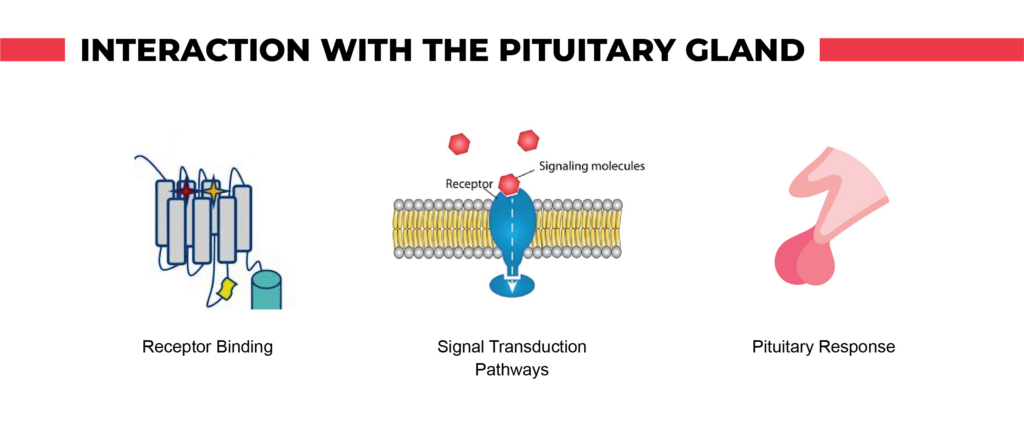
Sermorelin’s interaction with the pituitary gland involves a highly specific and intricate process within the endocrine system. Here’s a step-by-step scientific explanation of how Sermorelin interacts with the pituitary gland [5, 6]:
[*]Receptor Binding: Upon administration, Sermorelin selectively binds to growth hormone-releasing hormone receptors (GHRH receptors) on the somatotroph cells. This binding is highly specific, triggering a cascade of intracellular events.
[*]Signal Transduction Pathways: Receptor binding initiates signal transduction pathways within the somatotroph cells. These pathways involve various intracellular messengers and enzymes, leading to changes in cellular activity.
[*]cAMP Production: One key intracellular messenger activated by Sermorelin is cyclic adenosine monophosphate (cAMP). Increased cAMP levels act as a secondary messenger, signaling the cell to produce and release growth hormone.
[*]Pituitary Response: The elevated cAMP levels and other intracellular signals stimulate the somatotroph cells to synthesize and release endogenous human growth hormone (hGH). This release occurs in a pulsatile, episodic manner, mirroring the natural secretion pattern.
[*]Negative Feedback Regulation: Sermorelin-induced growth hormone release is subject to negative feedback regulation involving somatostatin, a neurohormone that inhibits further hGH secretion. This regulatory mechanism helps prevent excessive and sustained elevation of hGH levels.
[*]Physiological Effects: Released endogenous hGH then exerts its effects on target tissues, promoting growth, protein synthesis, and metabolic processes. Unlike exogenous growth hormone administration, which can lead to constant and potentially excessive levels, Sermorelin’s stimulation results in a more physiologically relevant episodic release.
Implications for Overall Growth Hormone Regulation
Increasing Growth Hormone (GH) levels in adults through replacement therapy with recombinant GH has demonstrated several beneficial effects, particularly in addressing adult GH deficiency. The following points highlight the positive outcomes associated with GH increase in adults:
[*]Body Composition Improvement: GH replacement therapy induces an increase in lean body mass and a decrease in fat mass. This contributes to a more favorable body composition, potentially reducing the risk of obesity-related health issues.
[*]Bone Health Enhancement: Long-term studies have shown that GH therapy leads to an increase in bone mineral density, which is crucial for bone health. This effect can be particularly beneficial in addressing conditions such as osteoporosis.
[*]Muscle Strength Enhancement: GH therapy has been linked to improvements in muscle strength. This is important for overall physical function and can have positive implications for individuals dealing with muscle-related issues.
[*]Quality of Life Enhancement: Health-related quality of life tends to increase after treatment with GH. This improvement may manifest in various aspects, including increased energy levels, mood, and overall well-being.
[*]Cardiovascular Health: GH replacement therapy has been associated with improvements in lipid profile and markers of cardiovascular risk. This suggests a potential cardiovascular protective effect, although long-term studies are needed to fully understand the implications.
While these benefits are noteworthy, it is crucial to acknowledge that GH replacement therapy is not without risks. Some studies suggest potential adverse effects, such as an increase in blood glucose, body mass index, and waist circumference. There are concerns about the development of diabetes and metabolic syndrome with long-term use.
Additionally, the relationship between GH therapy and survival remains unclear due to methodological shortcomings in long-term studies.
Conclusion
In conclusion, Sermorelin vs Ipamorelin is a somewhat difficult comparison to make. Increasing muscle mass, bone growth, immune system increase, both hold merrit. However, Sermorelin has never been approved for human use or peptide therapy. This means that while you could use Sermorelin (the stronger one) as a research chemical, you would not be able to procure it from a doctor or a peptide clinic.
Sermorelin would be slightly better for muscle development, tissue healing, collagen production, and combatting decreased energy. Again, the Ipamorelin is an approved therapy, so, might be a lot easier to procure.
Should I take Ipamorelin or Sermorelin?
Both of these peptides stimulate growth hormone release, both can lower body fat, body weight, and increase muscle mass. Sermorelin is the stronger version, but studies are lacking. Ipamorelin is more studies, but is weaker and is usually used in conjunction with CJC 1295.
What is better than Ipamorelin?
Sermorelin seems to be better for HGH releases compared to Ipamorelin. The latter is approved for human use, however, the former is not – yet.
What is the best peptide to release growth hormone?
Sermorelin seems to be the best peptide therapy for increasing Growth Hormone levels, however, there are not a ton of studies to support the peptide. Thus, a major concern is, of course, safety issues.
Do bodybuilders use Sermorelin?
Unlikely, bodybuilders are more likely to use pure Human Growth Hormone.
Can you take Ipamorelin and Sermorelin together?
While you could take both of these together, and they work through different pathways, Sermorelin is far stronger and would probably be more than enough.
Click here to view the article.



